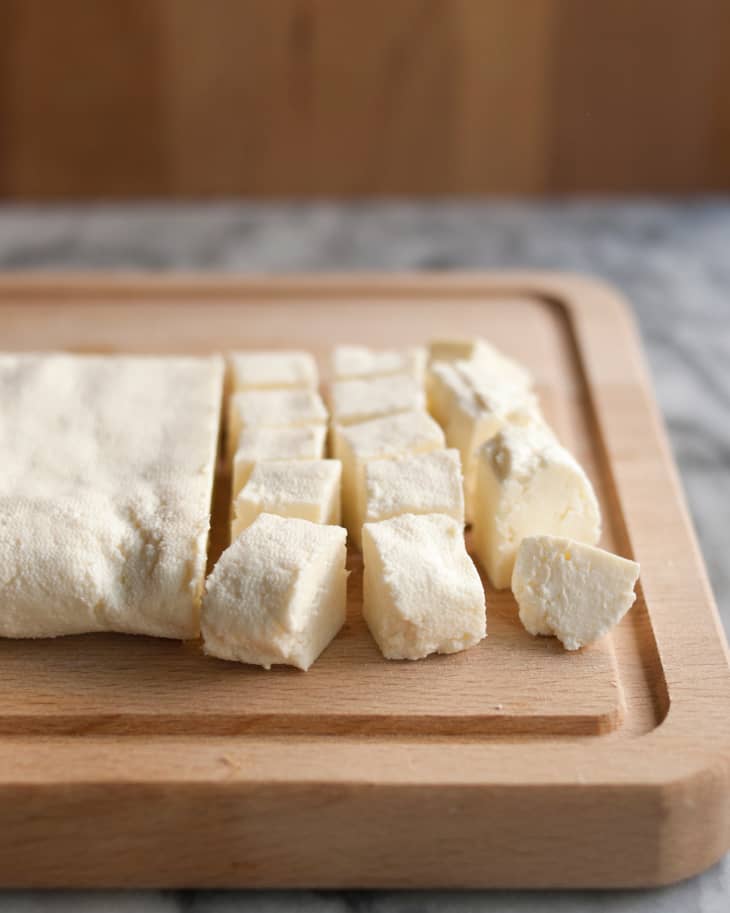How To Make Paneer Cheese in 30 Minutes

Paneer is the star ingredient in some of my most favorite Indian dishes — and probably yours too! I often find myself scooping just one more nibble of chewy, milky-tasting paneer from the dish long after I’m officially full. Sure, you can buy this firm cheese at the store to make your own homemade curries, but where’s the fun in that?!
If you have a pot, a strainer, and some cheesecloth, you can have fresh homemade paneer cheese in about 30 minutes. As the acidity in the lemon juice causes the milk to separate into curds and whey, remove the whey and press the curds, and you have a simple cheese.
Tip For Making Paneer Cheese
- Use whole milk in making paneer cheese.
- Avoid using ultra-high temperature (UHT) pasteurized milk.
- Make sure the milk doesn’t scald when you scrape the bottom of the pot.
- Press the curds for at least 15 minutes or up to 1 hour when you set a second plate on top of the package and weigh it down.
What is Paneer Cheese?
Paneer is a type of fresh cheese, meaning you can make it and eat it right away — no aging or culturing required. It’s also one of the easiest cheeses to make at home. All you need is milk, lemon juice or vinegar, and a bit of salt to season. When you mix the milk and lemon juice, the acidity in the lemon juice will cause the milk to separate into curds and whey. Remove the whey and press the curds, and you have a simple, basic cheese.
This cheese won’t melt or get gooey the way mozzarella or cheddar will, but with paneer, this is actually an advantage. Because it won’t melt, we can stir chunks into a soup or creamy curry, crumble it over flatbreads, or even skewer cubes onto kebabs and the cheese will keep its shape and chewy texture.
The Process of Making Paneer
Also avoid using ultra-high temperature (UHT) pasteurized milk, as this
pasteurization
Which Food is Best Eaten with Paneer?
Paneer has a fairly mild, milky flavor on its own, so it’s best when paired with strong, spicy flavors, like in classic Indian curries or dishes like saag paneer. It’s also nearly identical to Mexican queso fresco and Italian ricotta salata, and can usually be used in recipes calling for either of those ingredients.
How Long Does Paneer Cheese Last?
This fresh cheese won’t last long in the fridge, so if you don’t use it right away, definitely make sure you have plans for it within a few days. Personally, I’m not above sneaking leftover cubes straight from the fridge — a perfectly acceptable midnight snack.
How To Make Paneer Cheese
Makes 2 cups
Nutritional Info
Ingredients
- 1/2 gallon
whole milk, not UHT pasteurized
- 1/4 cup
lemon juice or vinegar
- 1/4 to 1/2 teaspoon
salt
Equipment
4-quart saucepan
Slotted spoon
Strainer or colander
Mixing bowl
Cheesecloth, nut bag, or other cloths for straining
Dinner plates
Weights, like a 32-ounce can of tomatoes
Instructions
Heat the milk: Pour the milk into the saucepan and set over medium heat. Bring the milk to a bare simmer — just below the boil at around 200°F. Stir the milk occasionally, scraping the bottom of the pot to make sure the milk doesn't scald. When ready, the milk will look foamy and steamy.
Add the lemon juice: Remove the milk from heat and stir in the lemon juice. The milk should begin to curdle immediately, but it's ok if it doesn't.
Let the milk stand for 10 minutes: Cover the milk and let stand for 10 minutes to give the acid time to completely separate the curds and whey. At the end of 10 minutes, the curds should be completely separated and the liquid should look yellow and watery. If the milk hasn't separated, try adding another tablespoon of acid. If it still won't separate, check your milk and be sure you are using non-UHT milk; this kind of milk won't separate.
Strain the curds: Set a strainer or colander over a mixing bowl and line it with cheesecloth, a nut bag, or other straining cloth. Carefully scoop or pour the curds into the strainer, letting the whey collect in the bowl beneath.
Squeeze the curds: Gather the cheesecloth in your hand and gently squeeze to remove the excess whey.
Salt the curds: Open the cheesecloth and sprinkle 1/4 teaspoon of salt over the curds. Stir gently and taste. Add more salt if desired.
Press the curds: Transfer the curds (still in the cheesecloth) to a large dinner plate. Shape them into a rough square and then fold the cheesecloth tightly around the curds to form a neat rectangular package. Set a second plate on top of the package and weigh it down. Press for at least 15 minutes or up to 1 hour.
Use or refrigerate the paneer: Once pressed, your paneer is finished and ready to use. You can use it immediately or refrigerate for up to two days. Refrigerated paneer will be firmer and less likely to crumble than fresh paneer.
Recipe Notes
Whole vs. 2% vs. Non-Fat Milk: While whole milk is our favorite for making ricotta, 2% milk can also be used, though the ricotta is slightly less rich and creamy. Avoid using skim and nonfat milks; these don't separate as easily into curds and whey.
Pasteurized Milk: Pasteurized milk is fine to use for making ricotta, but avoid UHT (Ultra High Temperature) pasteurized milk as this process changes the protein structure of the milk, preventing it from separating.
Using the Leftover Whey: The leftover whey can be used in place of water in any baking recipe, whizzed into smoothies, or drunk on its own over ice.
A version of this post and recipe were originally published July 21, 2008
